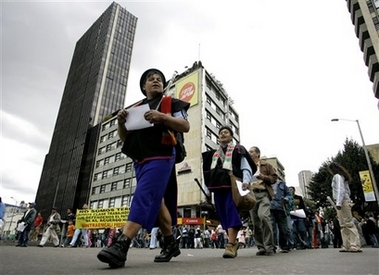Colombia: indigenous protest in capital
World War 4 Report 07/31/2007
Colombia: indigenous protest in capital

Some 1,700 indigenous people participated in a July 23-27 caravan to Bogota from Santander de Quilichao in the southwestern Colombian department of Cauca to demand peace, to call for popular unity and to oppose a "free trade" agreement (TLC, from its initials in Spanish) that the government of President Alvaro Uribe has signed with the US. Organized by the Regional Indigenous Council of Cauca (CRIC), the caravan included 25 buses with representatives of the Nasas, Coconucos, Totoroes, Siapidaras, Eperaras, Pastos, Embera Katios and Yanaconas. Security was provided by 300 guards armed only with traditional "rods of authority." There were also four doctors, six nurses, a number of traditional doctors and three ambulances to handle any health problems along the way.
The caravan made stops in Cali, Armenia and Ibague. In Melgar municipality in Cauca the caravan met with Gustavo Moncayo, who has been carrying out a "walk for peace" to call for the release of his son, a soldier held by the rebel Revolutionary Armed Forces of Colombia (FARC). Two traditional doctors gave Moncayo a ritual bath, and the guards presented him with a rod of authority. On the evening of July 26 the caravan arrived at Bogota and was met by dozens of supporters, along with representatives of the mayor’s office. On July 27 the participants marched to the Plaza de Bolivar in downtown Bogota.
Indigenous groups say they have been caught in a crossfire between the government, leftist rebels and right-wing paramiltaries. According to the CRIC, 584 indigenous people were murdered from 2002 to 2006 for political or social reasons, and the rate has been rising; the total number of such murders is 2,036 since 1974. A CRIC document said the march was meant "to find out what sort of independence people are referring to when they celebrate July 20 [Colombian Independence Day]." (El Tiempo, Cali, July 21; TeleSUR, July 23; Prensa Latina, July 23; Adital, July 25; Actualidad Etnica, Bogota, July 27; Univision, July 27 from AFP)
From Weekly News Update on the Americas, July 29





